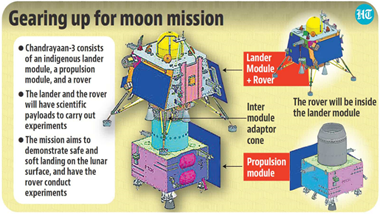

Context
Indian Space Research Organisation (ISRO), has integrated the spacecraft with the launch vehicle — Launch Vehicle Mark-III (LVM3) with an aim to launch Chandrayaan-3 in July.
What is Chandrayaan Mission?
- Chandrayaan-3 is a follow-on mission to Chandrayaan-2 to demonstrate end-to-end capability in safe landing and roving on the lunar surface.
- Need: The need for Chandrayaan-3 arose after the unsuccessful landing of the Vikram lander during Chandrayaan-2.
- This new mission is designed to demonstrate the essential landing skills required for the proposed lunar polar exploration mission in 2024, which India intends to carry out in collaboration with Japan.
- Aim: The mission aims to explore the Moon’s surface, particularly areas that have been deprived of sunlight for billions of years.
- Lunar Exploration: A lunar exploration oriented mission that aims at exploring the Moon and its resources through a series of robotic missions.
- Global Elite: Mission makes India only the 4th nation after US, Russia and China to land on the moon.

Composition
The Chandrayaan-3 spacecraft consists of three parts:
- Lander: The lander will be powered by four throttle-able engines and will feature a Laser Doppler Velocimeter (LDV).
- Rover: The rover will carry out chemical analysis of the lunar surface. Both the lander and the rover carry many scientific payloads for experiments on the lunar surface.
- Propulsion module: The propulsion module has one main function—to carry the lander and rover from “launch vehicle injection” to a 100-kilometre circular polar lunar orbit before it separates from the other modules.

|
Chandrayaan-3’s LVM-3
|


